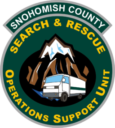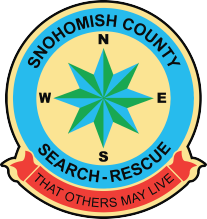
Welcome
Welcome to Operations Support!
WHO WE ARE…
Operations Support Unit is a group of volunteers that support the rest of Snohomish county Volunteer Search and Rescue.
OUR MISSION STATEMENT:
Operations Support Unit is part of the Snohomish County Volunteer Search and Rescue non-profit that serves all of Snohomish County and assists surrounding counties when needed. Our mission is to help bring lost or missing persons home, as well as assist the Snohomish County Sheriff in other needed operations by facilitating the command, paperwork, and communications as well as personnel support needed for successful missions by other specialized units.
Our volunteers spend countless hours on an average of 80 missions per year. Missions include: lost hikers, children, hunters, climbers, Alzheimer’s victims, missing aircraft, river and lake rescues, and assisting other agencies throughout Snohomish County and the Puget Sound area.
Snohomish county Volunteer Search and Rescue never charges for its rescue services. Our operation is mainly funded by private donations.
Operations Support Unit provides command, coordination, communications, and hospitality assistance to Snohomish County Volunteer Search and Rescue, the Snohomish County Sheriff’s Office, and the Snohomish Country Department of Emergency Management when those agencies request us. We help with search and rescue work, but are also called on to assist with natural disaster management. We are always on call 24 hours a day, 365 days a year.
WHAT WE DO…
COMMAND: Operations Support Unit (OSU) Command Operations facilitate Snohomish County Volunteer Search and Rescue (SCVSAR) operations by tracking personnel, equipment, and resources. Command is also responsible for creating the Snohomish County Sheriff’s documentation for the every mission. Command vehicle staff have no small task and create the same level of professional documentation for every call we take from a broken ankle to a missing child.
COMMUNICATIONS: Our communications ensure that missions go smoothly and safely. Without proper communications between the Sheriff, SNOPAC 911, ground and specialty teams, missions wouldn’t run safely or efficiently. We maintain a dedicated network of VHF radio repeaters to cover back country areas that are generally beyond the reach of cell phones and even the County’s first responder radio network. Our vehicles are equipped with VHF and 800MHz radios to communicate not only with ground teams but with Snohomish County Sheriff, fire, 911 dispatch, US Forest Service and aircraft from Snohomish County, other counties, Washington State, the Navy and Coast Guard to make sure all parties can coordinate their efforts.
MAPPING: Since many of our operations are in dense forests and not on trails, it is imperative that all teams know where to be and what obstacles they face to remain safe. Since we often use the Helicopter Rescue Team (HRT) during missions and receive coordinates from cellular or satellite providers, we also need to translate coordinates into Lat/Lon coordinates used by aircraft and to the USNG coordinates the ground teams use. The mission maps are constantly updated with the latest clues as the search mission progresses to provide the planner and incident commander the best available information to direct search efforts.
FOOD: The most essential of all of our services. The average mission has dozens of volunteers that work hard to bring someone’s loved one home. Without the hundreds of volunteers many lost or injured people would have an entirely different result. In order for these people to operate at their fullest they need food and drink to keep them going, and to be able to make it safely home. The food truck staff often works for hours straight in order to provide these services to upward of 50 volunteers. While the truck has a microwave, it is rarely used, the food truck staff cooks a hot meal
Contact Us
The OSU board is composed of elected representatives from within the membership, our elections are held yearly.
For more information regarding the Operations Support Unit, please contact us by e-mail.
Unit Officers
President – Seth Stone
Vice President – Quinton Cline
Secretary – Margaret Dunn
Training – Ashlie Erskine
Membership – Natalie Martin
Member at Large – Debra Draper
Board Members
Quinton Cline
Natalie Martin
Shelsea Eney
Prospective Members
The Prospective Member Packet and additional membership forms located on our volunteer page provides more information regarding how you can join Snohomish County Volunteer Search & Rescue (SCVSAR).
Meetings
If you are interested in joining please take time at home to complete the following:
• Create a FEMA ID
• IS-100.C Course
• IS-700.B Course
• Have a current First Aid and CPR
• Complete the Emergency worker form located HERE
• Complete the Personal Release form located HERE
• Organize your pack and equipment for a “pack check” HERE
Prepare
Plan ahead for any emergency!
Ten Essentials
Regardless of whether your backcountry adventure is short or long in duration, it’s essential to always be prepared. You never know when the unexpected might become a reality. Here are the Ten Essentials every backcountry traveler should carry.
Smart911
Since calls made to 911 from remote areas are often hard to communicate, we recommend that you sign up for Smart911.
Smart911 is a service that 911 (SNOPAC) uses to give more detailed information. Often when we arrive on scene for an injured hiker, we know very little about them. The more information 911 has, the better prepared we are. If we need additional resources sent up to your location on a trail for medical issues that you may have takes time.
Please create a Smart911 profile, locating you having more information such as your car make and model, knowing if you have a condition like diabetes can drastically reduce our time to find you or change the way rescue you. Sign up for Smart911 today!
REMINDER: Most of our missions are in wilderness environments. If you do get cell coverage, it’s usually not reliable. If you can, bring a satellite communicator, personal locator beacon (PLB), or Ham radio with you.
If you can’t bring any of the above alternatives, make sure you’ve left a hiking plan with a responsible person (that is not going hiking with you).
If you do go out with only a cellular phone, try calling 911. If that doesn’t work text 911 and a friend. Often times text messages will be sent when your phone gets signal, and short text messages do not need long once it has a signal. 911 (SNOPAC) is currently testing 911 text to dispatcher and it may not work. Texting the person that you left your hiking plan with might save your life.
If you get a hold of 911 please turn your phones GPS on. This helps your phone get a more precise location, and you can turn it off as soon as it shows your location accurately, or if your dispatcher tells you to. Don’t let it drain your battery, but let it reduce our search area.
911 working with the US Air Force Rescue Command, can remotely locate your phone in an emergency. The hiking plan helps them to determine if you are late, strict rules apply for 911 being able to use the location ability, and they have to weigh if you are truly late or just avoiding things in-town. Without a hiking plan, or other reasonable information they may have to wait for 72 hours before locating your phone.
If all else fails, know where the payphones, or landlines are on your way out. For example some campgrounds have payphones, and rangers at the ranger station can tell you where they are located along your route. Often times we get a call from one of the hiking party, who left to find a phone. Knowing where they are could save essential time and it could save lives!
Local Resources and Conditions
Avalanche Conditions
• Avalanche.org
• Alpenglows Northwest Weather, Snow and Avalanche Info
• Northwest Weather and Avalanche Center
Snohomish County Conditions
• Snohomish County Emergency Road Closures
• Snohomish County Flood Warnings
WSDOT Conditions
• WSDOT Mountain Pass Report
• WSDOT Traffic Alerts & Slowdowns
• WSDOT Weather Forecast
Weather Conditions
• KOMO 4 Weather Center
• KING 5 Weather Center
• KIRO 7 Weather Center
• National Weather Service – Seattle
• Turns All Year Weather
• Washington Online Weather
Other Conditions
• Department of Atmospheric Sciences, UW
• River and Stream Flows in Washington
• National Oceanic and Atmospheric Administration
National Forest and Parks
• Gifford Pinchot National Forest
• Mount Rainier National Park
• Mount Baker Snoqualmie National Forest
• North Cascades National Park
• Okanogan & Wenatchee National Forests
• Olympic National Forest
• Olympic National Park


 Donate
Donate